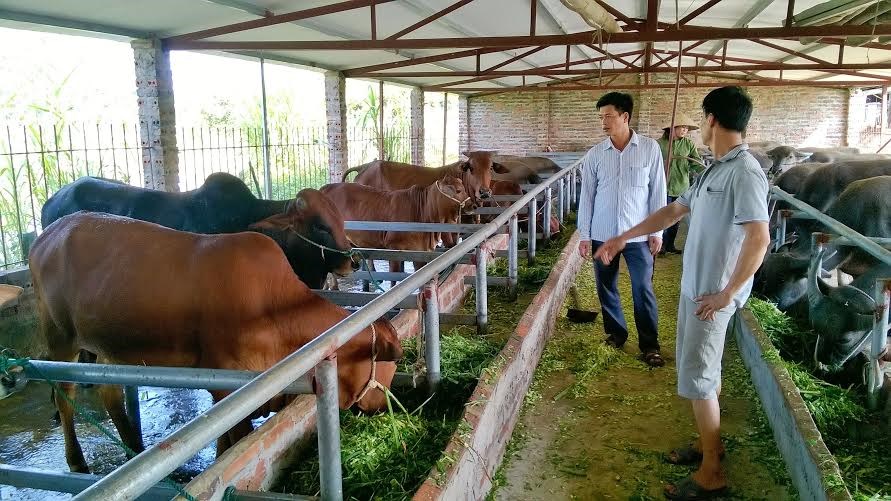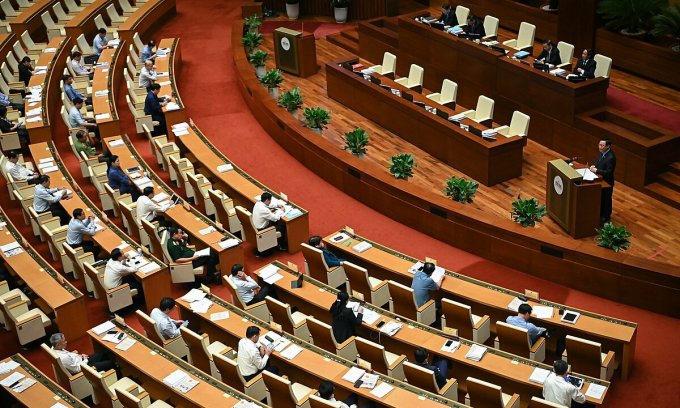Regulations on household husbandry under Vietnam law

Hello LSX. My family belongs to the local economic difficulties. Currently, my family has accumulated for a long time and finally has enough money to buy a herd of 7 cows and wants to raise them on a household scale. But we don’t know clearly about the regulations of the law. So about the matter “Regulations on household husbandry under Vietnam law” Let’s find out with LSX in the article below.
Legal grounds
- Law on Livestock 2018
- Decree 13/2020/ND-CP
How many types of livestock scale?
Pursuant to the provisions of Article 52 of the Law on Livestock Production 2018 on the scale of livestock production, specifically as follows:
“1. Breeding scale includes the following types:
a) Farm animal husbandry includes large-scale, medium-scale and small-scale livestock production;
b) Farming households.
2. The Government shall detail this Article.”
Besides, Article 21 of Decree 13/2020/ND-CP detailing the Law on Livestock 2018 on livestock scale as follows:
– Principles of determining livestock scale are prescribed as follows:
a) The scale of livestock and poultry raising is determined by the number of livestock units at the livestock establishment at the same time;
b) The scale of raising other types of livestock is determined by the number of livestock at the breeding establishment at the same time;
c) In the case of a mixed-breeding establishment consisting of cattle, poultry and other livestock, the scale of production shall include the total number of livestock units of cattle and poultry and the quantity of each other type of livestock.
– Scale of livestock and poultry production is regulated as follows:
a) Large-scale livestock production: From 300 livestock units or more;
b) Medium-scale farming: From 30 to under 300 livestock units;
c) Small-scale livestock production: From 10 to under 30 livestock units;
d) Farming households: Less than 10 livestock units.
– Management of livestock scale is regulated as follows:
a) Large-scale livestock production is managed according to the provisions of Articles 23 and 24 of this Decree;
b) Medium- and small-scale farm production must satisfy the conditions specified in Clause 1, Article 55 and Clause 2, Article 57 of the Law on Livestock.
In case of violation, the medium- and small-scale livestock production establishment must commit to remedy and ensure livestock production conditions within 06 months from the date of detection of the violation and send a report on remedial results. to the Department of Agriculture and Rural Development in the area. The Department of Agriculture and Rural Development conducts actual inspection of remedial results in case of necessity.
The Department of Agriculture and Rural Development is responsible for inspecting the breeding conditions of medium- and small-scale farms. The inspection frequency is every 3 years;
c) Household livestock production must satisfy the requirements specified in Article 56, Clause 2, Article 57 of the Law on Livestock.
– The livestock unit coefficient is specified as follows:
a) The livestock unit coefficient used as a basis for converting the number of livestock into livestock unit;
b) The livestock unit coefficient, the formula for converting the number of livestock to the livestock unit specified in Appendix V issued with this Decree.
– In case it is necessary to amend and supplement the livestock production scale and livestock unit coefficient, the Ministry of Agriculture and Rural Development shall submit it to the Government for consideration and decision on the amendment and supplementation according to the order and procedures for withdrawal. compact.
According to the above regulations, the basic livestock scale is divided into 2 types:
– Farm animal husbandry includes large-scale, medium-scale and small-scale farming;
– Livestock farming.
Along with that, to determine the scale of livestock production should be based on the following principles: The scale of livestock and poultry raising is determined by the number of livestock units at the livestock establishment at the same time. The scale of raising other livestock is determined by the number of livestock at the livestock establishment at the same time. For a mixed-breeding establishment consisting of cattle, poultry and other livestock, the livestock production scale shall include the total number of livestock units of cattle and poultry and the quantity of each other type of livestock.
What is farm farming?
Pursuant to the provisions of Clauses 1 and 3, Article 2 of the 2018 Law on Livestock, the definition of household farming is as follows:
“1 Animal husbandry is an economic – technical branch that includes activities in the fields of livestock breeds, animal feed, breeding conditions, processing and marketing of livestock products.
…
3. Household livestock production is a form of organizing livestock production activities at households.”
According to the above regulations, it can be understood that household farming is a form of organizing livestock production activities at households.
Regulations on household husbandry under Vietnam law
Pursuant to the provisions of Article 52 of the Law on Livestock 2018 on the scale of livestock production, specifically as follows:
“1. Breeding scale includes the following types:
a) Farm animal husbandry includes large-scale, medium-scale and small-scale livestock production;
b) Farming households.
2. The Government shall detail this Article.”
Thus, according to the above regulations, it can be seen that household farming is one of the types of livestock scale.
In addition, according to Clauses 1 and 2, Article 21 of Decree 13/2020/ND-CP detailing the livestock law on livestock scale, specifically as follows:
“1. The principles for determining the scale of livestock production are prescribed as follows:
a) The scale of livestock and poultry raising is determined by the number of livestock units at the livestock establishment at the same time;
b) The scale of raising other types of livestock is determined by the number of livestock at the breeding establishment at the same time;
c) In the case of a mixed-breeding establishment consisting of cattle, poultry and other livestock, the scale of production shall include the total number of livestock units of cattle and poultry and the quantity of each other type of livestock.
2. Scale of livestock and poultry production is regulated as follows:
a) Large-scale livestock production: From 300 livestock units or more;
b) Medium-scale farming: From 30 to under 300 livestock units;
c) Small-scale livestock production: From 10 to under 30 livestock units;
d) Farming: Less than 10 livestock units.”
According to regulations, the basic livestock scale is divided into 2 types:
– Farm animal husbandry includes large-scale, medium-scale and small-scale farming;
– Livestock farming.
Regulations on household husbandry under Vietnam law. Household livestock production is the scale of livestock production containing less than 10 livestock units. Thus, the case of your family raising cows with the number of 7 cows is suitable for the household scale.
Conditions for household farming scale
Pursuant to Article 56 of the 2018 Law on Livestock production, the conditions for farming households are as follows:
“Article 56. Farming households must meet the following requirements:
1. Breeding cages must be separate from people’s places of residence;
2. Periodically clean, disinfect and disinfect livestock barns and tools;
3. Take appropriate measures to clean and prevent epidemics; collect and treat manure, livestock wastewater, livestock carcasses and other livestock waste in accordance with the law on veterinary medicine and environmental protection.”
In addition, according to Clause 2, Article 57 of the 2018 Law on Livestock Production, livestock production organizations and individuals have the following obligations:
“2. Breeding organizations and individuals have the following obligations:
a) Make a declaration of livestock production according to the provisions of Article 54 of this Law;
b) Implement biosafety and environmental sanitation measures in animal husbandry;
c) Treat livestock waste in accordance with the law on environmental protection;
d) Ensuring humane treatment of livestock according to the provisions of law.”
According to that regulation, livestock production according to household scale needs to meet the following conditions:
– Breeding cages must be separate from people’s living quarters;
– Periodically clean, disinfect and disinfect livestock barns and tools;
– Take appropriate measures to clean and prevent epidemics; collection and treatment of manure, livestock wastewater, animal carcasses and other livestock wastes.
In addition, there are obligations: to declare livestock activities, to implement measures for biosecurity, environmental sanitation, to treat livestock waste, to ensure humane treatment of livestock.
Thus, household farming/household farming is a type of livestock scale. In the case of your family, the number of cows is 7 cows, it will be considered as a household scale. When raising cows on a household scale, it is necessary to meet the conditions as well as comply with the obligations prescribed by the law on animal husbandry.
Services of LSX
Prestigious professional services: Firstly, the team of consultants and consultants for many years in the field of civil status, and customer support.
On-time: Certainly, with the motto “Get your lawyer right at your fingertips”, we ensure the service always performs on time. The rights and interests of customers always come first.
Cost: Besides, LSX’s service costs are highly competitive; depending on the nature of the particular case. So, we want our guests to have the best possible service experience. Therefore, costs which guaranteed to be the most suitable and economical for customers.
Confidentiality of client information: Finally, all brand information of client LSX will be 100% confidential.
Please contact us immediately if you have any questions about “Regulations on household husbandry under Vietnam law”
Contact LSX
Finally, hopefully the information in the article will provide helpful information for readers and help you solve the problem “Regulations on household husbandry under Vietnam law” At the same time, LSX Law firm always has leading lawyers and legal consultants who will help you in legal matters of life. If you have any need, please get in touch with us via hotline: +84846175333 or Email: [email protected]
Please see more
- How much residential land does each household get in Vietnam?
- Development of housing of households and individuals in Vietnam
- Agricultural land use regime according to Vietnam land law
Frequently asked questions
Minimizing and classifying domestic solid waste at source, collecting and transferring classified domestic waste to the right place;
Minimizing, treating and discharging domestic wastewater in the right places; do not let pets cause unsanitary conditions in residential areas;
Do not emit exhaust gas, cause noise, vibration and other impacts that pollute the environment, adversely affect the surrounding residential community;
Pay expenses for waste collection, transportation and treatment services in accordance with law;
Participating in environmental protection activities in residential communities;
Household-scale livestock barns must ensure hygiene, not cause noise pollution, spread unpleasant odors; Waste from livestock production must be collected and treated according to the provisions of the law on environmental protection and other relevant laws.
According to regulations, when raising livestock on a farm scale, it is necessary to meet certain conditions such as the location of the farm in accordance with the socio-economic development strategy of the locality, region, the strategy of livestock development feed; have sufficient water sources to ensure quality for livestock production and treatment of livestock waste; There are stables, livestock equipment suitable for each type of animal, …
Pursuant to Clauses 1 and 2, Article 19 of Decree 155/2016/ND-CP stipulates as follows:
A fine ranging from VND 5,000,000 to VND 10,000,000 shall be imposed for discharging septic tank cleaning wastes, toxic chemicals and disease-causing sources into the environment in contravention of regulations on environmental protection.
For acts of polluting the soil, water (groundwater, surface water inside and outside the premises of the establishment) or the air in excess of the technical regulations on environment of land, water and surrounding air, the fines shall be as follows: after:
A fine ranging from VND 50,000,000 to VND 80,000,000 shall be imposed if the pollutant content (environmental parameters) in soil, water or air exceeds the technical regulation by less than 3 times for environmental parameters. hazardous or less than 05 times for normal environmental parameters;
A fine ranging from VND 80,000,000 to VND 100,000,000 shall be imposed if the pollutant content (environmental parameters) in soil, water or air exceeds the technical regulation from 3 times to under 5 times. hazardous environmental parameters or from 05 times to less than 10 times for normal environmental parameters;
A fine ranging from VND 100,000,000 to VND 150,000,000 shall be imposed if the pollutant content (environmental parameters) in soil, water or air exceeds the technical regulation by 05 times or more, for environmental parameters. hazardous environment or 10 times or more for normal environmental parameters.
Conclusion: So the above is Regulations on household husbandry under Vietnam law. Hopefully with this article can help you in life, please always follow and read our good articles on the website: lsxlawfirm.com




